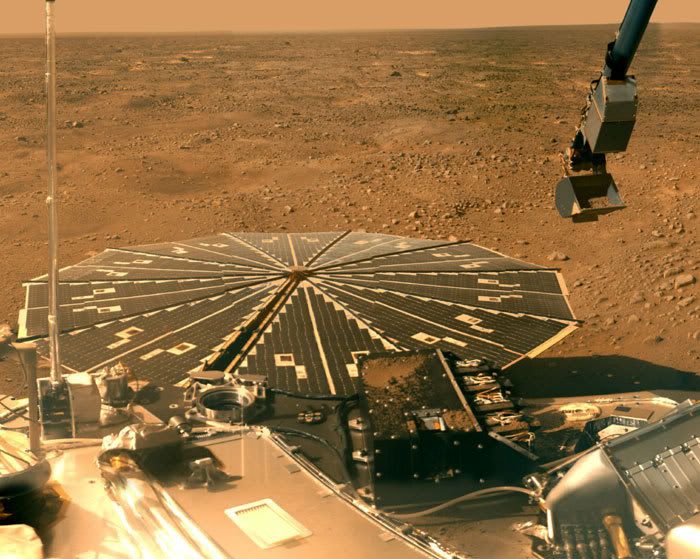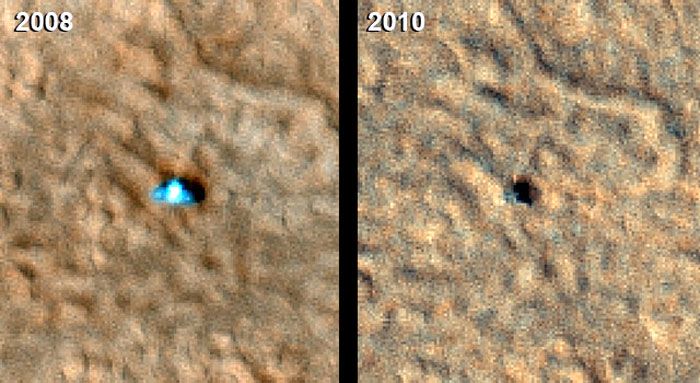
TWO YEARS AGO TODAY, the Phoenix Mars lander safely touched down on the Red Planet...starting a very successful mission that almost lasted 6 months even though it was only suppose to survive for 3. During its mission, Phoenix came in contact with water ice at its landing site on the Martian northern plain, which is why NASA sent the spacecraft there in the first place. The space agency had hoped the lander would come back to life after the mission came to an end on November 10, 2008 (due to low power being generated by Phoenix’s twin solar panels because of the onset of Martian winter), but a new image taken by the Mars Reconnaissance Orbiter in space shows that there is no chance that Phoenix will ever come back to life.

The photos above show before-and-after shots of Phoenix at its landing site. In the left picture, Phoenix’s solar panels (the two blue circles that are on each side of the white oval that would be the lander’s flight deck) are glistening in the sunlight as the spacecraft was alive and well in 2008. In the picture to the right, the left solar panel is noticeably missing...most likely due to it snapping off from the spacecraft after a huge amount of carbon dioxide ice accumulated on the panel's surface during the year-long winter. This type of damage was predicted long ago...even though NASA had the Mars Odyssey orbiter (which has been circling the planet since 2002) listen in on any radio signal that may have been transmitted from Phoenix if it returned from the dead earlier this year. The only thing Odyssey heard for the past couple of months was silence.

While it is unfortunate that Phoenix won’t rise from the ashes (so to speak) to resume its study of water ice on the northern plain, I’m glad that it will permanently be silent. The images above show all the Martian soil that accidentally dropped onto the Phoenix DVD by the lander’s robotic arm during the mission. Even though the chances of any of the dirt getting underneath the disc and damaging its readable surface are slim (since Phoenix is obviously stationary and on leveled ground), I was still a bit annoyed that the DVD was getting covered by debris falling from the arm. If Phoenix had come back to life, who knows just how much more dirt would be covering the disc by the time the lander fell silent again? I’m glad that Phoenix is now nothing more than a man-made memorial on Mars. The Pasadena-based Planetary Society contributed the Phoenix DVD for the mission...and stated that the disc was supposed to last for at least 500 years (assuming the carbon dioxide ice didn’t damage the disc either, knock on wood that it didn't). Here’s hoping that will be the case, and that the DVD will be left unmolested even when humans finally touch down on the surface of Mars one day.
All images above courtesy of NASA / JPL - Caltech / University of Arizona / Texas A&M University
PHOENIX Blog Entries Archive:
May 8, 2007
July 28, 2007
August 3, 2007
August 4, 2007
August 8, 2007
October 25, 2007
April 11, 2008
April 25, 2008
May 1, 2008
May 11, 2008
May 18, 2008
May 24, 2008
May 25, 2008
May 27, 2008
June 18, 2008
August 4, 2008
November 10, 2008
May 25, 2009
August 26, 2009

No comments:
Post a Comment